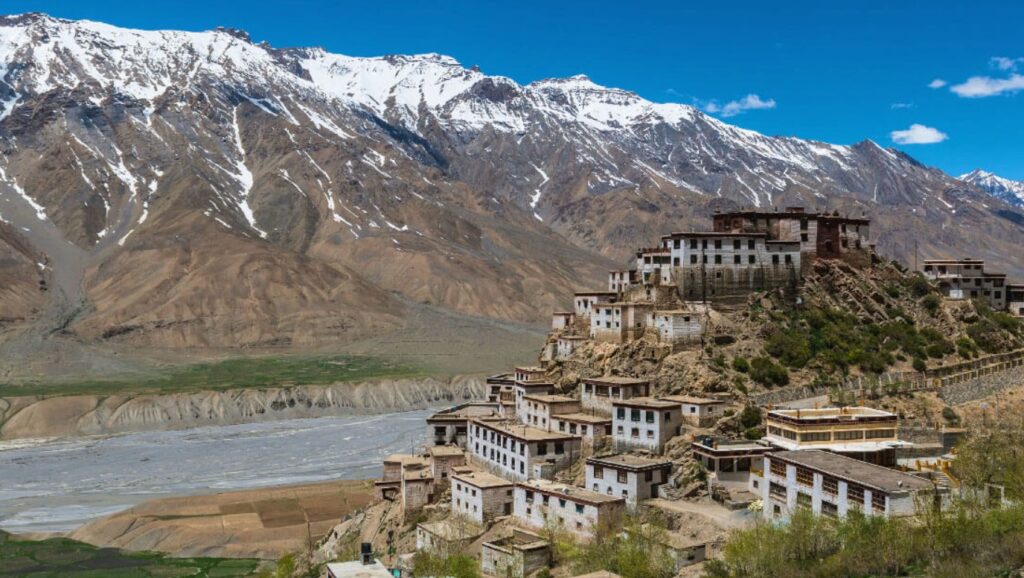“Discover Lahaul and Spiti District in Himachal Pradesh, known for its breathtaking landscapes, majestic peaks, adventure opportunities, and rich cultural heritage.”

Explore Lahaul and Spiti: Majestic Peaks & Remote Beauty
Lahaul and Spiti is a captivating district nestled in the northern Indian state of Himachal Pradesh. With its breathtaking landscapes, rich culture, and unique way of life, the district stands as a testament to nature’s beauty and human resilience.
Separated by the formidable Rohtang Pass, Lahaul and Spiti are two distinct valleys, each with its own charm. Lahaul, encompassing the Chandra Valley, is characterized by green meadows, fertile fields, and the pristine Chandra River. In contrast, Spiti, often referred to as “Little Tibet,” boasts a stark and barren terrain, with rugged mountains and the meandering Spiti River carving its way through the valley. This diversity of landscapes makes the district a paradise for nature enthusiasts and adventurers alike.
Lahaul and Spiti are renowned for their unique cultural heritage. Influenced by Tibetan Buddhism, the monasteries in the region stand as testaments to centuries of spiritual devotion. The Key Monastery, perched atop a hill, is a prominent religious center and offers panoramic views of the surrounding landscape. Festivals like Losar, the Tibetan New Year, bring the community together in a vibrant display of traditional rituals, dance, and music. The district’s inhabitants have adapted to the harsh environment over generations, practicing a sustainable way of life that respects nature’s balance.
Despite its serene beauty, life in Lahaul and Spiti is not without challenges. The district’s remote location and harsh climate, characterized by heavy snowfall and extreme cold, limit accessibility for much of the year. The people here have learned to make the most of the short summer months, engaging in agriculture and animal husbandry. The cultivation of barley, peas, and potatoes sustains the population, while the rearing of yaks and dzos provides wool, milk, and transportation.
Road connectivity to the region has improved over the years, allowing travelers to explore the district’s hidden treasures. Adventure seekers are drawn to Lahaul and Spiti for its high-altitude treks, including the famous Spiti to Leh route. The mesmerizing Chandratal Lake, often referred to as the “Moon Lake,” is another highlight, shimmering like a sapphire amidst the rugged terrain.
In recent years, Lahaul and Spiti have also seen a growing interest from tourists seeking to experience its untouched beauty. However, sustainable tourism practices are crucial to preserve the fragile ecosystem and protect the indigenous way of life. Balancing the influx of visitors with environmental conservation remains a challenge that requires careful planning and community involvement.
In essence, Lahaul and Spiti District is a realm of awe-inspiring landscapes, ancient traditions, and a resilient human spirit. Its unique blend of natural beauty and cultural richness creates an experience that lingers in the hearts of all who venture into this remote and remarkable corner of the world.
Famous Places in Lahul & Spiti District
Lahaul and Spiti District is home to several renowned places that showcase the district’s stunning natural beauty, rich cultural heritage, and unique way of life. Some of the famous places in Lahaul and Spiti are:
Key Monastery: Perched on a hilltop overlooking the Spiti Valley, Key Monastery is one of the most iconic and largest monasteries in the region. Its stunning architecture, intricate murals, and serene surroundings make it a must-visit destination.
Chandratal Lake: Known as the “Moon Lake,” Chandratal is a high-altitude lake that captivates visitors with its shimmering blue waters against a backdrop of rugged mountains. The trek to Chandratal is an adventure in itself, offering breathtaking views along the way.
Kaza: The headquarters of Lahaul and Spiti District, Kaza serves as a gateway to various attractions in the region. It’s a charming town with a vibrant market, and it offers access to nearby monasteries and scenic landscapes.
Tabo Monastery: Often referred to as the “Ajanta of the Himalayas,” Tabo Monastery is one of the oldest and most significant monastic complexes in the Spiti Valley. The monastery houses ancient murals, sculptures, and manuscripts, offering a glimpse into the region’s rich history.
Kunzum Pass: This high mountain pass connects Lahaul Valley with the Spiti Valley and is a sight to behold with its panoramic views of snow-capped peaks. It’s a popular spot for trekkers and adventure enthusiasts.
Losar: The first village of the Spiti Valley, Losar is known for its traditional houses and stunning landscapes. It serves as the base for treks to popular destinations and offers a glimpse into the local way of life.
Dhankar Monastery: Perched precariously on a cliff overlooking the confluence of the Spiti and Pin Rivers, Dhankar Monastery is a place of spiritual significance and offers breathtaking views of the surrounding valleys.
Lhalung Monastery: Nestled in the fertile fields of the Lingti Valley, Lhalung Monastery is known for its unique architecture and ancient murals. The village of Lhalung itself is a picturesque spot surrounded by lush greenery.
Suraj Tal: This high-altitude lake is often referred to as the “Lake of the Sun God.” It’s one of the highest lakes in India and offers stunning reflections of the surrounding peaks.
Pin Valley National Park: This national park is home to a diverse range of flora and fauna, including the snow leopard. It’s a haven for nature enthusiasts and wildlife photographers.
These are just a few of the many incredible places that Lahaul and Spiti District has to offer. Each destination showcases the district’s unique blend of natural beauty, cultural heritage, and spiritual significance.
Read More :-
